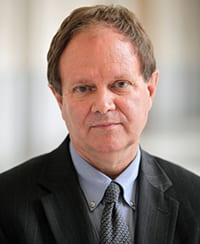Meet our Faculty Advisory Board Member, James F. Hollifield, Academic Director of the John Goodwin Tower Center for Public Policy and International Affairs and Professor at SMU. Learn more about his previous and current work and research on migration.
What first interested you in migration?

Studying in France in the mid-1970s and getting to know a lot of immigrant students from all over the world but primarily from North Africa. I even tried to learn Arabic, but my primary foreign language then was Russian, which I studied at the University of Grenoble. I knew a lot of Soviet students and some Warsaw Pact spies, etc. I did not get mixed up with espionage, but I did get to practice my Russian!
In the past, you have been an advisor to various governments, as well as international organizations. During that time, did you find common issues or concerns throughout different countries regarding migration?
The short answer to your question is not really…
The interests of various states (and their governments) in migration vary widely from one region to another and even within regions. Take the EU, for example, which I know well. When Chancellor Merkel of Germany made the courageous decision to take almost one million asylum seekers in 2015-16 (she said “Wir schaffen das” … “we can do this”), she expected other EU member states to step up and take responsibility in this humanitarian crisis; but most (with a few exceptions like Sweden and Austria) refused to take large numbers of asylum seekers, and the countries of East Central Europe (led by Hungary and Poland) refused to take any.
So even in a highly integrated part of the world, like the EU, interests vary widely. And if you look at the interests between the sending societies/states of the global south and those of the receiving societies/states in the north, the asymmetry of interests is quite high.
This makes it difficult to get international cooperation to manage migration. What happens often is the adoption of emergency, ad hoc policies to stop or slow the movement of people—this is what happened in Europe when the EU, led by Germany, paid the Turks to stop the influx of people from Africa, the Middle East, and South Asia; and it is what happened between the U.S. and Mexico to stop the flow of Central American asylum seekers to the southern U.S. border. The Trump administration threatened Mexico with trade sanctions and other harsh measures to get Mexican agreement to harden the Mexican border with the so-called Northern Triangle countries and to force asylum seekers to remain in Mexico while their cases are pending in the U.S.
I could tell you more about how all this works in various international organizations, like the UNHCR, the ILO, and others, but I’ll leave that for another time.
Can you tell us about the current research you are working on?
Current research is focused on migration interdependence and the relationship between migration, economic, and especially human development … in the Americas and in Africa and the Middle East.
How do you think the Texas-Mexico Center can contribute to the Texas-Mexico relationship?
The idea for the creation of the Texas-Mexico Center was that the future of the U.S.-Mexico relationship depends heavily on the Texas-Mexico relationship. Texas and Mexico are inextricably linked by history, culture, migration, trade, and investments. The Texas-Mexico Center studies the key issues related to all of these to understand the nature and the evolution of the relationship. Integration of the Texas and Mexican economies is more important than ever (just look at the numbers), and this is especially true for North Texas and the DFW area. By sponsoring cutting-edge research, SMU and the Texas-Mexico Center are contributing to the formulation and implementation of policies that promote greater integration, cooperation, and understanding between Texas and Mexico. We are building bridges, not walls.

0 comments on “Faculty Advisory Board Profile: James Hollifield” Add yours →